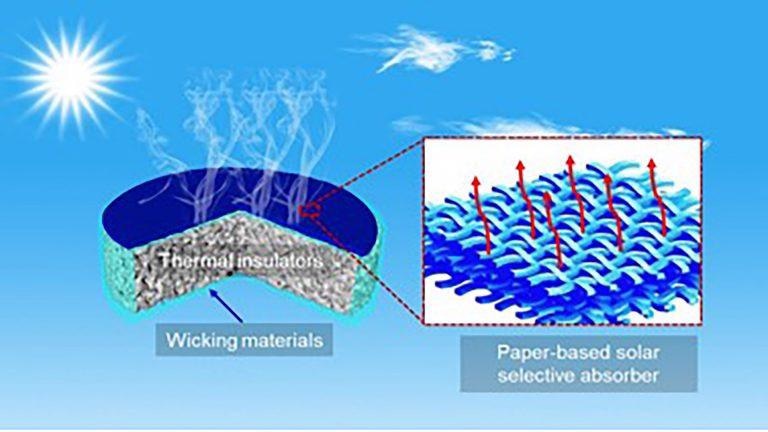Apr 28 2021
Although Earth has a vast amount of water, a major portion of it is non-potable seawater, with freshwater making up only about 2.5% of the total. Many places around the world hence experience acute water scarcities.
 Solar-powered desalination unit consists of three layers: wicking material, a thermal insulator, and a paper-based solar light absorber containing titanium. Image Credit: Chao Chang.
Solar-powered desalination unit consists of three layers: wicking material, a thermal insulator, and a paper-based solar light absorber containing titanium. Image Credit: Chao Chang.
Researchers in China report the development of a very efficient desalination device driven by solar energy in AIP Advances, by AIP Publishing. The device comprises a titanium-containing layer, titanium nitride oxide (TiNO), that can absorb solar energy. The TiNO is placed on an exclusive type of paper and foam that enables the solar absorber to float on seawater.
When sunlight hits the titanium layer, it heats quickly, causing the water to vaporize. By putting the unit into a transparent container with a sloped quartz roof, the water vapor can be condensed and collected, creating plenty of freshwater.
In the solar energy field, TiNO is a common commercial solar absorbing coating, widely used in solar hot water systems and in photovoltaic units. It has a high solar absorption rate and a low thermal emittance and can effectively convert solar energy into thermal energy.
Chao Chang, Study Author, Dalian Maritime University
The authors formulated a method for depositing a TiNO layer using a procedure called magnetron sputtering. They used a unique type of very porous paper referred to as airlaid paper that serves as a wicking material to supply water from the seawater reservoir. Airlaid paper is composed of wood fibers and is often used in disposable diapers.
The evaporation unit consists of three parts: the top TiNO layer, the bottom airlaid paper, and a thermal insulator. The insulation layer is polyethylene foam, which has numerous air-filled pores that trap heat and enable the multi-layer unit to float on top of a seawater reservoir, thus reducing the loss of heat to the environment.
The porous airlaid paper used as the substrate for the TiNO solar absorber can be reused and recycled more than 30 times.
Chao Chang, Study Author, Dalian Maritime University
Salt precipitation on the TiNO surface could hamper the efficiency, but the team found that even after a prolonged time, no salt layer developed on the surface. They explain the porous feature of the paper wicks away any salt that might develop on the surface, thereby returning it to the seawater reservoir.
Ordinary seawater has a salinity of more than 75,000 mg of salt per liter, while ordinary drinking water’s salinity is about 200 mg/L. The desalination unit could reduce the salinity of seawater to less than 2 mg/L.
High efficiency, low cost, and lack of fouling for this desalination technology indicate that it has the potential to help find a solution to the world’s freshwater scarcity.
Journal Reference:
Chang, C., et al. (2021) Porous TiNO solar-driven interfacial evaporator for high-efficiency seawater desalination. AIP Advances. doi.org/10.1063/5.0047390.